Creative Container Gardening for Small Spaces
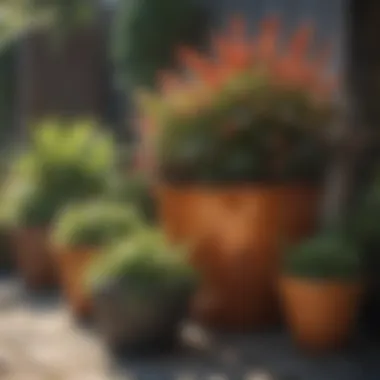
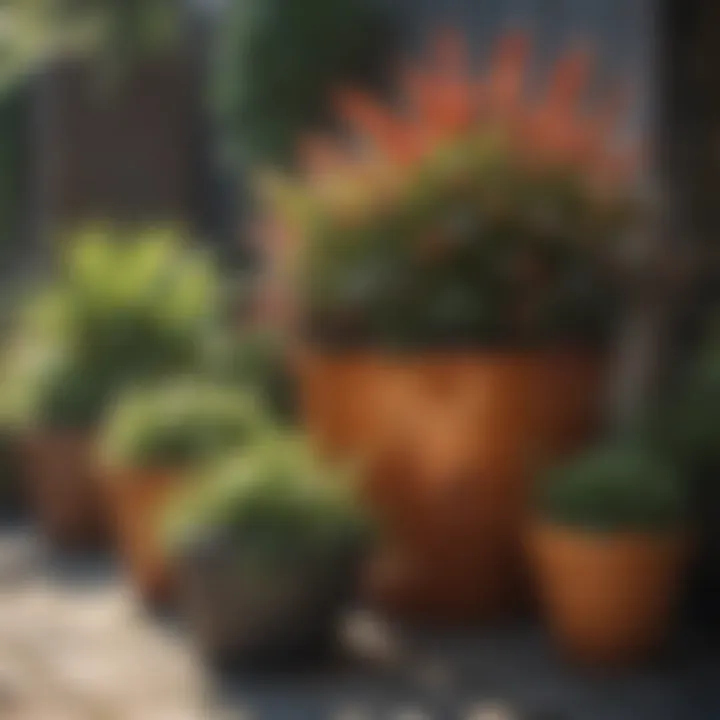
Intro
Creative container gardening is more than a pastime; it's a vibrant expression of one's taste and creativity within the confines of limited space. For many urban dwellers, precious square footage often limits their aspirations for a green sanctuary. However, with the right guidance and imaginative application, even the most petite patios or balconies can be transformed into verdant retreats, brimming with life and aesthetic charm.
This exploration will delve into various effective strategies for selecting the right containers, choosing appropriate plant types, and designing beautiful arrangements that not only enhance living spaces but also reflect personal style. Beyond just aesthetics, container gardening nurtures a connection with nature, providing mental respite in our often chaotic urban environments.
Design Inspiration
When thinking about container gardening, design inspiration plays a pivotal role in creating a cohesive and inviting space. Here, we’ll explore current trends and color palettes that resonate well with today’s design ethos.
Current Interior Design Trends
As design philosophies evolve, the integration of plants into aesthetic schemes has swept through homes like wildfire. To stay on trend, consider the following elements in your container gardening endeavors:
- Biophilic Design: This approach emphasizes the connection between indoor environments and nature, encouraging the use of plants as integral features in design.
- Minimalism: Simplistic design allows the natural beauty of plants to shine, focusing on fewer, well-chosen elements that create tranquility.
- Eclectic Styles: Don’t shy from mixing modern and rustic; a hodgepodge of container types and plant species can result in a captivating, individualized look.
Marrying these design concepts with innovative container choices can lead to unforgettable settings, whether on a balcony or a dining table.
Color Palettes and Their Effects
Colors hold remarkable power in influencing mood and aesthetic appeal. The choice of hues in your containers and plant arrangements can dictate the overall vibe of your space.
- Pastels: Soft colors can evoke calmness and serenity, making them perfect for cozy corners. Think of muted pinks or light greens.
- Bold Shades: Vibrant colors can energize a space. Rich oranges and deep blues can add a lively touch, creating an environment that feels spontaneous and inviting.
- Monochromatic Schemes: Sticking to varying shades of a single color can provide a sophisticated, unified look that allows different elements to blend seamlessly.
"The right color underlines the beauty of plants and can set the mood of your space where you showcase them."
These insights invite you to consider the visual impact of your plant arrangements. Rather than simply placing plants into pots, think about how to integrate design principles that set your container garden apart.
Practical Container Gardening Ideas
Following this inspiration, let’s dive into practical tips that couple creativity with actionable advice suited for plant lovers and novices alike. Even the smallest space holds the potential for a personal paradise.
Understanding Container Gardening
Container gardening is not just a hobby; it is a transformative approach to harnessing the art of planting in confined or unconventional spaces. This section sheds light on why understanding container gardening is pivotal in today's urbanized world. Urban living often comes with constraints on space, where traditional gardening may feel like a distant fantasy. However, the creative process of container gardening makes it possible to cultivate our botanical desires, even in small nooks of balconies, patios, or even indoors. With its practicality, accessibility, and aesthetic charm, container gardening allows individuals to blend nature seamlessly into their living spaces.
Defining Container Gardening
Container gardening refers to the practice of growing plants in various types of containers rather than in the ground. These containers can range from terracotta pots and wooden boxes to creative repurposed items like old teacups or painted buckets. The beauty of this style of gardening lies in its versatility. Whether you have a tiny apartment or a large house, container gardening suits all lifestyles. It simplifies the gardening process while giving room for creativity, as each container can showcase a unique combination of plant types, colors, and arrangements.
The idea that you can plant anything from herbs to flowers or vegetables in a pot speaks volumes about the adaptability of this technique. When you think about it, container gardening transforms the mundane into extraordinary; you are not just planting—you are curating an experience.
Historical Context
The origins of container gardening can be traced back to ancient civilizations. For instance, the Hanging Gardens of Babylon, one of the Seven Wonders of the Ancient World, is a brilliant testament to this practice. While the details of its existence remain murky, it hints at the long-standing significance of curating plants in elevated, artistic settings. Further down the timeline, during the Roman Empire, wealthy citizens adorned their villas with intricate container gardens, using elaborate pots made from clay and stone.
As the centuries rolled by, the Victorian era brought about a renewed interest in botanical pursuits. It was during this time that container gardening began to gain traction among the middle class, who sought to bring greenery into their homes, often using conservatories and window boxes. Fast forward to the 20th century, container gardening took a twist with the rise of urbanization. As cities expanded, and living spaces became smaller, the concept was rediscovered and reshaped into a practical solution for city dwellers.
Today, container gardening stands at the crossroads of tradition and innovation. It continues to evolve, incorporating modern materials and techniques while connecting individuals with their love of nature. The blend of aesthetics, practicality, and connection to history makes understanding the roots of container gardening not just beneficial—it's essential.
Benefits of Container Gardening
Container gardening offers a plethora of advantages that go beyond mere aesthetics. It provides a unique opportunity to cultivate plants in limited spaces, making it ideal for urban dwellers and those with small yards or balconies. By examining the various benefits, we can see how this gardening method not only enhances our environments but also improves our quality of life.
Space Efficiency
In a world where every square inch counts, space efficiency stands out as a critical benefit. Container gardens fit neatly into nooks and crannies that traditional gardens cannot. Whether it's a small patio, a balcony, or even a kitchen window, pots and planters can be arranged to maximize greenery without encroaching on living space.
Some interesting ideas to consider include:
- Tiered arrangements: Utilizing shelves or staircases can create a tiered effect that draws the eye upward, allowing for more plants without increasing the footprint.
- Corner setups: Using corner planters can transform underused spaces into thriving green escapes.
Moreover, you can tailor your container selection to fit your specific environment. For example, deep pots are better suited for root vegetables, whereas shallow ones might be ideal for herbs. With these choices, you easily adapt your gardening approach to the layout of your home, ensuring no precious space goes to waste.
Accessibility for All
Another essential aspect of container gardening is its accessibility. This method invites everyone—regardless of physical ability—to engage in gardening. Containers can be placed at various heights to accommodate individuals with limited mobility, allowing them to enjoy the nourishing act of planting without straining. Furthermore, gardeners with physical limitations can opt for raised beds or potting tables, alleviating the need to bend over or kneel.
In addition to physical accessibility, container gardening offers a wealth of varieties that cater to diverse horticultural interests, motivating many to dig into their green thumbs. From aromatic herbs like basil and thyme to vibrant flowers and hardy succulents, there is something for everyone.
By welcoming all skill levels and physical abilities, container gardening fosters a sense of community. Neighbors can share tips, swap plants, or even collaborate on larger projects, creating bonds within their living spaces.
Design Versatility
Container gardening speaks the language of creativity, highlighting design versatility as a key feature. The variety of containers available makes it easy to express personal style or complement existing decor. From classic terracotta pots to modern geometric designs, the choices are seemingly endless. Moreover, color, texture, and material can all play significant roles in adding depth and character to any space.
- Grouping for impact: Arranging pots in groups rather than placing them individually can create stunning focal points. Varying heights, shapes, and colors can evoke different themes—from tropical havens to minimalist Zen gardens.
- Seasonal changes: Changing plant selections based on seasons allows for dynamic designs that evolve throughout the year. In spring, bright blooms can reign, while autumn might bring the warm hues of ornamental grasses.
In summary, the benefits of container gardening extend far beyond a simple means of planting. It encourages efficient use of space, promotes accessibility, and opens up an avenue for undeniable creative expression—all while making our environments greener and more inviting. As this article continues, we will delve deeper into the vital components of successful container gardening, guiding readers toward a thriving plant-filled life.
Selecting the Right Containers
When it comes to container gardening, choosing the right containers is fundamental to both the aesthetic appeal and the health of your plants. Each material brings its own strengths and weaknesses, impacting not only the growth of plants but also the overall look of your space. Thus, understanding the various options available can be the linchpin to a successful and vibrant garden, especially in small spaces where every detail matters.
Material Considerations
Choosing the material for your containers is akin to dressin' a house for a party; it sets the tone and style. Let’s delve into various materials typically used.
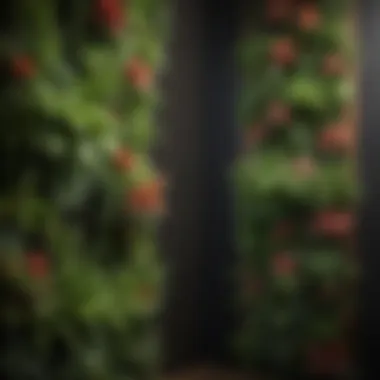
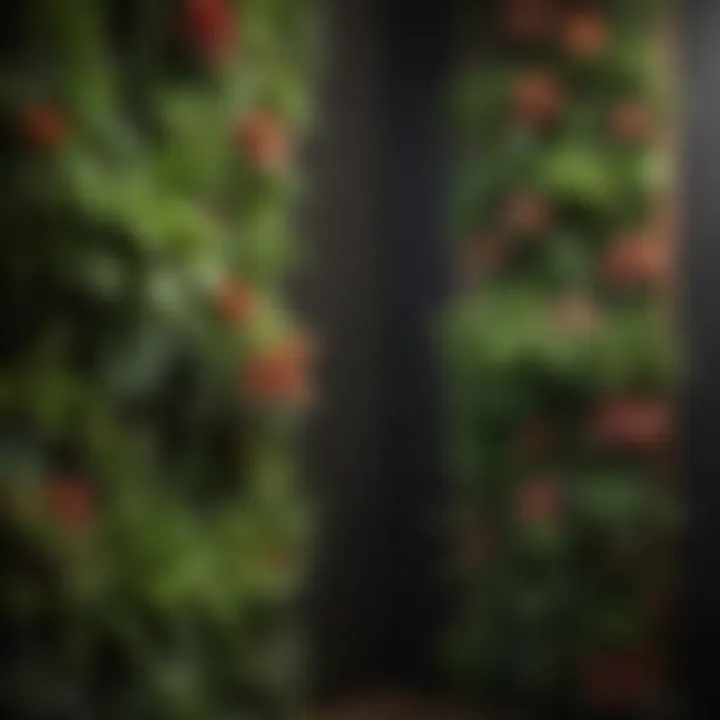
Wood
Wooden containers evoke a natural charm, radiating warmth and beauty. A key characteristic of wood is its insulating properties; it helps moderate temperature fluctuations in soil, shielding plant roots from extreme heat or cold. This quality makes wood a favored choice among gardeners.
One unique feature of wooden pots is that they can be constructed to various sizes or shapes, making them adaptable for different plant types or gardening spaces. However, do keep in mind that wood is prone to rot, particularly if it fails to get enough drainage. Using untreated wood might not hold up for long, but options like cedar or redwood are more durable and resistant to decay. Overall, wooden containers can provide an organic touch to your container garden, but attention to maintenance is essential.
Metal
When you think of metal containers, think sturdiness and durability. Metals like galvanized steel and zinc have become increasingly popular due to their robust nature. They can withstand weather and heavy use, making them a smart choice for outdoor gardens. Furthermore, if aesthetics matter, metal containers can lend an industrial chic vibe to your space.
However, one must consider the heat retention factor. Metal can absorb and radiate heat, which might dry out the soil quicker than other materials. To tackle this, lining the inside or choosing reflective colors can mitigate extreme temperature shifts. All in all, metal containers are perfect for those wanting long-lasting and stylish pots, but one should watch the watering habits closely.
Plastic
The lightweight and often colorful options of plastic containers can't be overlooked. One advantageous trait of plastic is its affordability; for those on a budget, plastic pots are an accessible choice. They come in a range of styles, sizes, and colors, offering an easy way to jazz up your garden.
A standout feature of plastic is its resistance to corrosion and fading. Unlike metal or wood, plastic doesn’t rot, making it a long-term investment for your gardening needs. However, the downside is its durability; in regions with extreme temperatures, lower-quality plastic can become brittle over time. So while plastic containers are often a practical and versatile option, selecting quality materials is crucial for longevity.
Clay
Last but not least, clay pots, including terracotta, hold a special place in container gardening. Their porosity allows for an optimal airflow around the roots, promoting healthy plant growth. Clay offers an aesthetically pleasing, rustic look that many gardeners adore.
However, it's worth noting that these pots can dry out quickly due to their absorbent nature, which means vigilant watering is necessary. Additionally, clay can be quite heavy, making them a tad cumbersome to move about. Therefore, if you’re planning a container garden that might need rearranging from time to time, perhaps opt for lighter alternatives. Clay containers undoubtedly provide an earthy feel to gardening, but understanding their needs is paramount.
Size Matters
When it comes to size, it’s a case of balancing plant needs and visual appeal. Bigger isn't always better; using a container that is too large might seem attractive but can lead to excess moisture retention that can drown plant roots. Conversely, too small a pot may stunt growth. The right size maintains the perfect balance of stability and growth potential.
Drainage Requirements
A fundamental principle in container gardening revolves around drainage. Without proper drainage, plants may easily fall victim to root rot. Ensuring that your chosen containers have drainage holes is imperative. If using materials like metal or plastic, consider additional drainage measures like adding a layer of gravel at the bottom.
Key takeaway: Selecting the right containers is a meticulous process, but it leads to a thriving container garden that showcases the artistry of small-space planting. Understanding material characteristics, size, and drainage needs will set the stage for a flourishing green landscape.
Choosing Suitable Plants
Choosing the right plants is a linchpin in the realm of container gardening. It’s not just about what looks pretty; it’s critical to ensure that the plants thrive in their confined spaces while also complimenting each other and the overall design of your arrangement. When navigating this process, consider factors such as the plant's growth habits, light requirements, and water needs.
It's also worth noting that the microclimate in a container can be different from your garden bed or ground soil. The soil tends to dry out quicker, so selecting plants that can tolerate such conditions will pave the way toward a blooming success. This section will take a closer look at the various types of plants suited for containers, exploring their unique traits and the overall contributions they make toward enhancing your gardening experience.
Types of Plants for Containers
Herbs
Herbs like basil, thyme, and rosemary are ace players when it comes to container gardening. They not only add flavor to your meals, but they also come with the bonus of aroma that no one can resist. One standout trait of herbs is their compact growth habit, making them ideal for smaller spaces. Plus, they require minimal maintenance, thus making the whole process simpler for those just starting out in the gardening game.
The sole downside could be that herbs may not last long-term in the same container due to their shallow root systems. But hey, that just means it’s time to refresh your selection when they hit a wall!
Flowers
When thinking of flowers, choices like petunias, geraniums, and marigolds really shine. They add a splash of color and can be particularly uplifting. The vibrant colors of flowers serve a dual purpose, bringing joy and harmonizing with the aesthetic appeal of your space.
One of the unique features of flowers is their pollinator-friendly nature, often attracting bees and butterflies, which is a nice touch for any container garden. However, keep in mind that some flowering plants can be high maintenance, requiring regular deadheading and monitoring for pests.
Foliage Plants
Foliage plants such as ferns, hostas, or snake plants can elevate your container garden by bringing in textures and greens. These plants thrive primarily for their visual impact. They often have a longer lifespan in containers compared to seasonal blooms. Foliage plants can act as the backbone of your arrangement, providing structure and contrast.
Be aware that while they can tolerate varying light conditions, too much sun may lead to scorched leaves, so placement is crucial.
Vegetables
Growing vegetables in containers can be a rewarding venture, beneficial for both culinary enthusiasts and space-challenged gardeners. Varieties like cherry tomatoes, peppers, or lettuce can thrive when confined, offering both harvest and aesthetic appeal. The beauty of growing vegetables in containers lies in their accessibility; even a small container on a balcony can yield a fresh salad.
One trade-off is that they may require more diligent care and fertilization compared to ornamental plants. But the payoff of harvesting your own produce often outweighs this effort.
Plant Pairing Techniques
Pairing plants involves intentional selection to enhance visual appeal and support overall plant health. Using a technique called thrillers, fillers, and spillers can guide your choices:
- Thrillers: Tall, striking plants that draw the eye upward (e.g., ornamental grasses).
- Fillers: Mid-height plants that fill in the gaps, contributing color (e.g., busy lizzies).
- Spillers: Trailing plants that create a soft edge over the container (e.g., ivy).
This pairing method not only ensures a balanced look but also accommodates varying growth rates, helping to maintain a cohesive design.
Seasonal Considerations
Thinking about the seasons can greatly inform your choices. Annuals, such as petunias or zinnias, bloom during specific seasons and can be swapped out as new ones appear in the market. Perennials, on the other hand, require more foresight but offer the chance for repeated beauty year after year.
In colder months, consider plants that can withstand frost, such as pansies or ornamental cabbage. Understanding your local climate and selecting plants that thrive during specific periods can save a gardener from heartache and foster a successful growing experience.
Designing Container Arrangements
Designing container arrangements is not just about placing a few pots on a balcony or patio. It plays a pivotal role in enhancing the overall aesthetics and functionality of small spaces. When done thoughtfully, it transforms plain areas into vibrant focal points that can tie together a look or theme inside or outside a home. Understanding the principles of arrangement helps optimize space while allowing personal expression through unique plant selections and designs. The right arrangement can elevate a simple container garden into a spectacular visual statement that reflects one’s style and enhances any surrounding environment.
Focal Points and Balance
When arranging plants, the concept of focal points and balance cannot be overstated. A focal point draws the eye and creates interest. This can be achieved by using a statement plant—something towering or uniquely colored—that stands out among other elements. For example, a tall fiddle leaf fig perched in a rustic, weathered pot can command attention, whereas softer, trailing plants like ivy can provide balance around it.
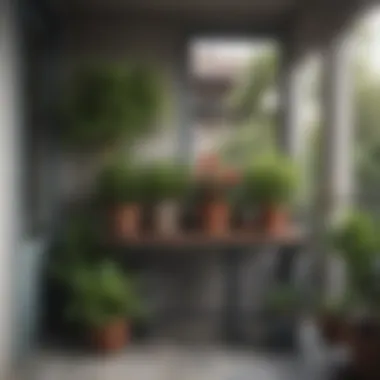
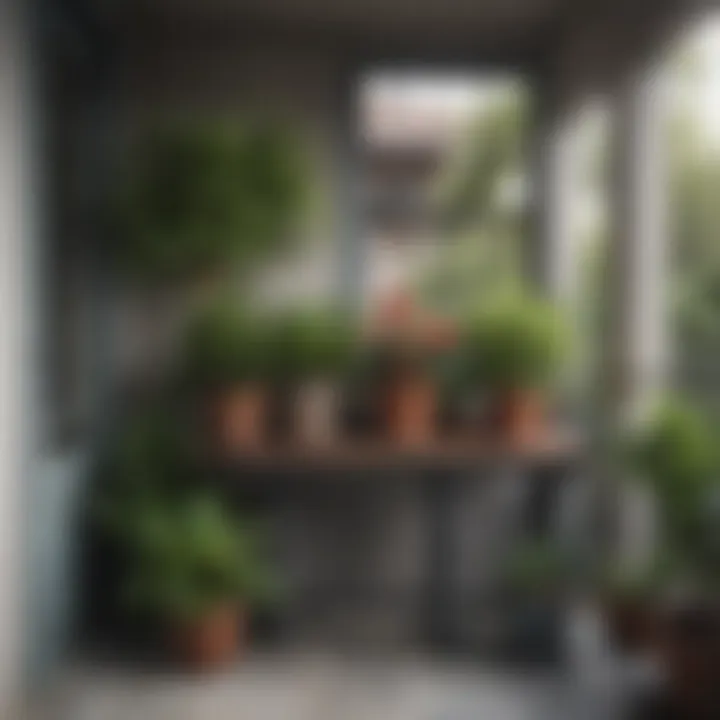
Balancing height and volume is just as crucial. Mixing plants of various sizes adds depth and dimension to your design. A cluster of smaller herbs arranged around a medium-sized perennial creates an inviting scene. The key is to avoid overcrowding the space; enough negative space between plants allows each to shine without competing for attention. Moreover, consider the visual weight of each container. Grouping similar styles enhances cohesiveness while varying textures keeps the design interesting.
Color Theory in Container Gardening
Color theory involves understanding how colors interact and the psychological effects they can evoke. In container gardening, this is significant, as the color palette can transform an arrangement dramatically. Warm colors like reds, oranges, and yellows instill a sense of energy and warmth, making them perfect for energetic spaces or sun-soaked areas. Meanwhile, cool colors—blues, greens, and purples—tend to evoke calm and relaxation, suitable for tranquil spaces such as a reading nook on a balcony.
When selecting plants, aim for harmony, but do not shy away from contrast. For instance, pairing the vibrant yellow flowers of dahlia with the deep blue of spearmint creates visual excitement. Think of using foliage as a backdrop. Greenery can help to emphasize blossoms and provide continuity, tying assorted colors together seamlessly.
Layering Techniques
Layering is a technique that introduces depth and sophistication to plant arrangements. It involves structuring plants at different heights and depths to create visual intrigue. A successful layered arrangement might include tall plants at the back, medium plants in the middle, and trailing plants spilling over the edges of the pot. Consider the whimsical quality of string of hearts hanging delicately over the side of a tall pot filled with zinnias.
Using varying container sizes allows for more diverse layering. Ascertain that each layer is visible and complements the surrounding elements—this could also mean mixing different pots and styles to enhance the character of the arrangement, adding an element of surprise and individuality.
Seasonal Adaptations
One of the beauties of container gardening is its adaptability to the seasons. Changing your plant selections to reflect the season keeps the design fresh and lively. In spring, consider introducing pansies and primroses for a pop of color, while summer could spotlight colorful petunias or fragrant basil. Autumn lends itself to earthy tones with chrysanthemums and ornamental grasses, while winter arrangements might feature hardy evergreens or seasonal decorations like pine cones and twigs among the plants.
To wrap it up, be mindful of each season's strengths when determining which plants to use. This not only enhances your container arrangements aesthetically but also plays into the natural growing cycles, making for healthier plants that thrive in their designated time.
Designing with these elements ensures that your container garden is not only visually appealing but also functional, allowing for a truly enjoyable plant experience in limited spaces.
Maintenance Techniques for Containers
Maintaining a thriving container garden is not just about planting and watering; it's a delicate dance that involves attentive care and a bit of know-how. These container gardens, whether sprouting from a porch, a balcony, or even a windowsill, have specific needs that, if met, will yield rewarding results and lasting beauty. Emphasizing maintenance techniques is integral to achieving resilient plant health, vibrant aesthetics, and ultimately a satisfying gardening experience. The specific methods used help ensure that your greens flourish, allowing for creative expression.
Watering Strategies
Watering is the lifeblood of any container garden. Unlike in-ground plants, containers can dry out quickly, particularly in hot weather or windy conditions. A solid watering strategy can make all the difference.
- Check the Soil: Stick your finger about an inch deep into the soil. If it feels dry, it’s time to water. Conversely, if it’s still moist, hold off a bit.
- Water Evenly: Pour water slowly until it seeps from the drainage holes at the bottom of the container. This ensures the entire root system is hydrated.
- Time of Day: Early morning is ideal for watering, as it allows plants to absorb moisture before peak heat hits during the day.
- Consider the Weather: If rain is forecasted, you might want to adapt your plan. Too much water can be just as harmful as too little.
Regularly monitoring the moisture levels not only feeds the plants but also keeps pests at bay and reduces the risk of root rot.
Fertilization Protocols
Fertilizing is a crucial aspect of maintaining container plants. Since they lack the nutritional resources found in natural soil, these plants rely on us for the right balance of nutrients. Here are a few pointers:
- Type of Fertilizer: Liquids are often easier to integrate into a watering schedule, whereas slow-release pellets offer convenience. Choose based on your gardening style.
- Application Timing: During the active growing season, which for most is spring and summer, aim to fertilize every 4-6 weeks.
- Follow Directions: Over-fertilization can lead to nutrient burn. Adhering to package instructions prevents this mishap.
Incorporating organic fertilizers, like compost or worm castings, can also provide beneficial microbes to the plants, fostering a healthy ecosystem in your containers.
Pruning Best Practices
Pruning may seem daunting, but it’s a fantastic method to promote growth and maintain the aesthetic appeal of your container gardens. Different plants have varied needs, but a few guidelines remain consistent:
- Remove Dead or Diseased Leaves: This keeps the plant healthy and encourages new growth. Regularly inspect your plants for those pesky yellowing or wilted leaves.
- Shape Your Plants: For flowering plants, pinch or prune back the stems. This encourages bushier growth and often, more blooms.
- Timing is Key: After flowering, many plants benefit from a good trim, leading to a healthy resurgence in growth.
Pruning enhances not only the health of the plant but also its presentation and performance.
Pest and Disease Management
Pests and diseases can be a container gardener’s worst nightmare, yet with vigilant practices, you can mitigate their effects. Here’s how to stay one step ahead:
- Regular Monitoring: Keep an eye out for irregularities in leaf coloration or holes in leaves. This could signal a pest issue.
- Natural Remedies: Consider using neem oil or insecticidal soap for common pests like aphids, while encouraging beneficial insects like ladybugs.
- Rotation: If certain pests keep coming back, consider rotating your container plants. This disrupts their life cycles and can reduce infestations.
- Companion Planting: Integrate plants that deter pests by their scent or structure. For instance, marigolds can help ward off nematodes and other pests.
Effective pest and disease management leads to healthier plants and makes the joys of container gardening all the more rewarding.
Innovative Container Gardening Ideas
In the world of container gardening, creativity is the name of the game. When space is limited, thinking outside the traditional planter box opens the door to a plethora of innovative ideas that not only optimize your area but also give your green thumb a chance to shine. Innovative container gardening solutions provide not just utility but also aesthetic appeal, making every arrangement a conversation starter. From vertical setups to clever repurposing of materials, these ideas enhance artistic expression, bring life to otherwise dull corners, and even contribute to sustainable living practices.
Vertical Gardening Solutions
Vertical gardening is where innovation meets necessity. In small spaces, utilizing height rather than floor space can make a world of difference. Consider a wall-mounted planter for herbs or flowers. This technique allows you to create a lush green wall that serves as a living art piece.
- Benefits of Vertical Gardening
- Maximizes space by using vertical surfaces
- Improves air circulation around your plants
- Provides a unique perspective on plant arrangement
You might want to try structures like pallet gardens, where old shipping pallets are transformed into vertical beds. Simply sand and paint, fill with soil, and plant away! Another option is hanging pocket planters, which can be made of felt or canvas. These are perfect for trailing plants like string of hearts or vibrant herbs.
Hanging Gardens
Hanging gardens offer an unexpected twist to container gardening, dripping with charm and whimsy. Imagine your favorite flowers or lush greenery filtering sunlight from above, creating a perfect visual delight. These gardens can be hung from ceilings, hooks, or even mounted on walls.
- Why Consider a Hanging Garden?
- Adds dimension and vertical appeal
- Creates a sense of intimacy and coziness
- Can be a striking focal point in your decor
When crafting a hanging garden, consider using macramé hangers for a touch of bohemian flair. Or, opt for suspended shelving to hold multiple pots, like peace lilies or succulents. The beauty here lies in the interplay of light and shadows as your plants grow and flourish.
Repurposed Materials
One of the most fulfilling aspects of innovative container gardening is the opportunity to repurpose everyday materials. This not only reduces waste but also adds a unique character to your garden. Think of all the items you might toss in the trash—these could become your next gardening project!
- Materials To Consider:
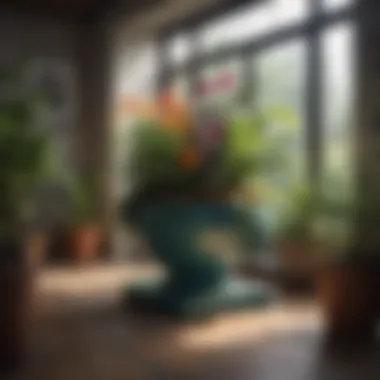

- Old teacups for petite succulents
- Wooden crates as rustic plant stands
- Tin cans can become quirky herb containers
You could even opt for repurposing wine bottles as self-watering planters. Cut the bottle in half, invert the top half into the bottom, and fill the base with soil. This method saves water and adds a whimsical element. A well-placed birdcage can also serve as a fantastic focal point when filled with trailing plants or flowers.
"Innovation thrives on creativity and daring to rethink what we discard."
Sustainable Practices in Container Gardening
In the landscape of gardening, sustainability isn't just a buzzword; it’s a necessary approach for a more ecological future. When it comes to container gardening, embracing sustainable practices can transform not only the health of your plants but also your environmental footprint. Opting for sustainable methods contributes to a greener planet while fostering a more intimate connection to nature. Through practices that are considerate to local ecosystems, gardeners can find joy in the beauty of their plants while also ensuring these spaces thrive for generations to come.
Using Native Plants
Native plants are the unsung heroes of sustainable gardening. These species have adapted over time to the local climate and soil conditions, making them remarkably resilient. When planted in containers, they offer various advantages. For one, they require less water and fertilization than their non-native counterparts. This not only reduces your workload but also conserves water resources.
Moreover, growing native plants helps to support local wildlife, including pollinators like bees and butterflies. By providing crucial habitats and food sources, you create a vibrant ecosystem right in your backyard or balcony. Beautiful options may include black-eyed Susans or coneflowers, both of which can add splashes of color while attracting beneficial insects.
"Embracing local flora not only personalizes your gardening space but also strengthens the ecological web that sustains us all."
Water Conservation Techniques
Water scarcity is becoming a pressing issue globally, making conservation techniques in container gardening essential. Efficient watering strategies can reduce waste and ensure your plants receive the right amount of moisture. Here are a few methods to consider:
- Self-watering Planters: These ingenious designs have a reservoir at the bottom, allowing plants to take up water as needed, thus preventing overwatering.
- Mulching: Adding a layer of mulch on top of the soil helps retain moisture, reducing the frequency of watering needed.
- Rainwater Harvesting: Consider setting up a collection system for rainwater that can be used for your pots. This not only conserves water but also provides your plants with untreated, chemical-free water.
By implementing these techniques, you won’t just be saving water; you’ll be promoting efficient practices that others can emulate in their gardening journeys.
Organic Gardening Methods
Organic gardening is a holistic approach that nurtures the soil and promotes biodiversity. When you choose organic methods for your container plants, you avoid synthetic fertilizers and pesticides, resulting in healthier plants and safer harvests. Here are some notable organic techniques:
- Composting: Utilize kitchen scraps and yard waste to create nutrient-rich compost that can improve soil quality in your containers.
- Natural Pest Deterrents: Methods like using neem oil or introducing beneficial insects can help manage pest populations without harming the environment.
- Crop Rotation: Change out plants in your containers every season to naturally disrupt pest cycles and promote healthy soil.
These practices encourage plant health while reducing the chance of chemical runoff that could affect local waterways. By embracing organic gardening methods in your container garden, you cultivate a sanctuary that respects nature while enjoying the fruits of your labor.
The Role of Container Gardening in Urban Living
Container gardening has blossomed into a vital practice, especially for those navigating the bustling urban landscape where spacious gardens can seem like a dream. Imagine the vibrancy of a small patio or balcony transformed into a lush oasis, rich with colors and textures. Container gardening allows city dwellers to cultivate their passion for plants despite often limited square footage.
In urban settings, the pressure on real estate has made yard space both a luxury and a rarity. This brings forth several benefits and considerations worth exploring:
- Maximizing Limited Spaces: With container gardening, every nook and cranny becomes a potential plant haven. Whether it’s a weathered chair turned into a planter or recycled cans hanging from a balcony rail, creativity knows no bounds. These innovative arrangements allow for a variety of plants to flourish without needing an expansive backyard.
- Aesthetic Enhancement: Urban environments can often feel gray and sterile. By introducing greenery, individuals elevate their immediate surroundings. This small act can go a long way in softening harsh landscapes and providing a sense of calm amidst the chaos of city life.
- Clean Air and Microclimates: Plants naturally purify the air and contribute to improved air quality. Container gardens can create tiny ecosystems that benefit both the gardener and the environment. They also help in managing urban heat by providing some cooling relief, making strolls through a neighborhood more enjoyable.
"Green spaces in cities are not just a luxury; they are essential for mental and physical well-being."
- Encouraging Biodiversity: Urban centers typically exhibit a lack of biodiversity. Container gardening allows individuals to create habitats that support various species, from pollinators like bees to birds and butterflies. This enriches the local ecosystem and creates a connection to nature that might otherwise be elusive.
Through container gardening, individuals can exercise autonomy over their living spaces, instilling a sense of pride and accomplishment. This adaptability plays a crucial role in the urban gardening movement and underscores the importance of green initiatives in cities.
Creating Green Spaces in Small Areas
The notion of transforming small areas into green sanctuaries speaks volumes about urban container gardening. Far from being merely an afterthought, these spaces are crafted with intent. It’s not uncommon to see vibrant green balconies, lovely window boxes, or even stylishly arranged pots adorning small patios. Each space can reflect the gardener's personality, values, and creativity.
- Vertical Gardens: Think beyond traditional pots. Vertical gardening makes the most of limited floor space. Wall-mounted planters, living walls, or cascading vines can be visually striking and highly functional. They bring greenery closer to the eye and utilize vertical space effectively. Plants like trailing succulents or ivy can serve as excellent candidates for this method.
- Layering for Visual Interest: Use varying heights, shapes, and sizes to create depth. Mixing small and tall containers enhances the visual experience. For example, combining a tall ornamental grass with low-growing herbs offers a striking contras.
- Seasonal Planting: By changing the plants with the seasons, one can keep the space fresh. Spring blooms like pansies can transition into summer's sun-loving petunias, and in fall, rich foliage can carry the beauty into winter.
By thoughtfully transforming small areas into vibrant green sanctuaries, container gardening thrives among small-space dwellers, fostering a connection with nature that's crucial in today's concrete jungles.
Community Gardening Initiatives
With urbanization on the rise, the concept of community gardening emerges as a beacon of hope for fostering camaraderie and sustainability. Community gardens offer a shared space for individuals to delve into gardening, making it not just about growing plants but also about cultivating relationships.
These initiatives are pivotal for various reasons:
- Shared Knowledge and Resources: Community gardens serve as educational hubs. Experienced gardeners can pass on tips and techniques to novices, creating a cycle of learning. Workshops on organic gardening, pest management, and seasonal planting take place in these communal spaces, making gardening accessible to everyone.
- Strengthening Community Bonds: Gardening inherently promotes teamwork and collaboration. Neighbors come together to sow seeds, tend to plants, and harvest the fruits of their labor. This social interaction can knit tighter connections among residents, fostering a sense of community.
- Food Security: In many urban areas, access to fresh produce can be limited. Community gardens can serve as a sustainable source of fruits and vegetables, empowering individuals to eat healthily and understand where their food comes from. This venture not only nourishes bodies but also encourages a dialogue about food systems and sustainability.
Community gardening aligns with the principles of container gardening, allowing individuals to maximize urban spaces while sharing experiences and knowledge. Each initiative, although often modest, becomes a focal point for nurturing community spirit.
In summary, container gardening plays a key role in urban living, enabling individuals to create lush, green spaces even in the smallest of areas while simultaneously fostering community engagement and sustainability. As more urban dwellers embrace container gardening, the concrete jungles can begin to bloom, turning cities into greener, more livable spaces.
Future Directions for Container Gardening
As our lives shift more towards urban living, the concept of container gardening continues to be a relevant and necessary topic. With a growing population in cities where space is often limited, the art of cultivating plants in various containers becomes essential not only for aesthetics but also for sustainability and self-sufficiency. Future directions in container gardening reflect the integration of innovative practices and technological advancements that enhance our ability to enjoy greenery in small spaces.
This section aims to explore how evolving techniques and trends reshape our interaction with gardening, influencing both environmental practices and personal enjoyment.
Technological Advancements
The role of technology in container gardening has taken off, expanding the possibilities for urban gardeners. Smart gardening devices are becoming increasingly prevalent, allowing plant enthusiasts to monitor conditions from afar. Key components of this technological wave include:
- Smart Sensors: These devices can relay real-time data about soil moisture, nutrient levels, and light exposure directly to your smartphone, taking the guesswork out of watering and care.
- Automated Watering Systems: Systems like drip irrigation offer timed watering while conserving water, a factor especially important in areas facing drought.
- Hydroponic and Aeroponic Systems: These soilless growing methods are gaining traction, enabling individuals to grow plants with less space and fewer resources.
With these advancements, container gardening becomes less about traditional practices and more about integrating modern solutions that simplify plant care and enhance the growing experience.
Emerging Trends
The future of container gardening is not only shaped by technology but also by evolving consumer preferences and cultural imprints. Here are several noteworthy trends worth noting:
- Biophilic Design: This concept underscores the natural connection between people and nature. Indoor plants are making their way into workplaces and homes in ways that blend seamlessly with interiors, promoting well-being and productivity.
- Edible Landscapes: There’s a growing interest in incorporating vegetables and herbs into ornamental arrangements. Using containers for aesthetic food production allows individuals to embrace both beauty and practicality in their spaces.
- Community Involvement: Urban gardening initiatives are increasingly promoting community engagement. Shared container gardens can foster social ties while enhancing local ecosystems.
As we move forward, it’s clear container gardening will keep adapting to our changing environments and needs. The marriage of technology and creativity opens doors for even the most constrained spaces to flourish with life.
"Innovation in container gardening not only nurtures plants but also our connection to the environment."
In this pursuit of greener urban living, the container gardening community continues to thrive through creativity, adaptability, and an openness to new ideas. Homeowners, interior design enthusiasts, and gardening aficionados are thus encouraged to embrace these future directions, planting seeds of change both literally and figuratively.















